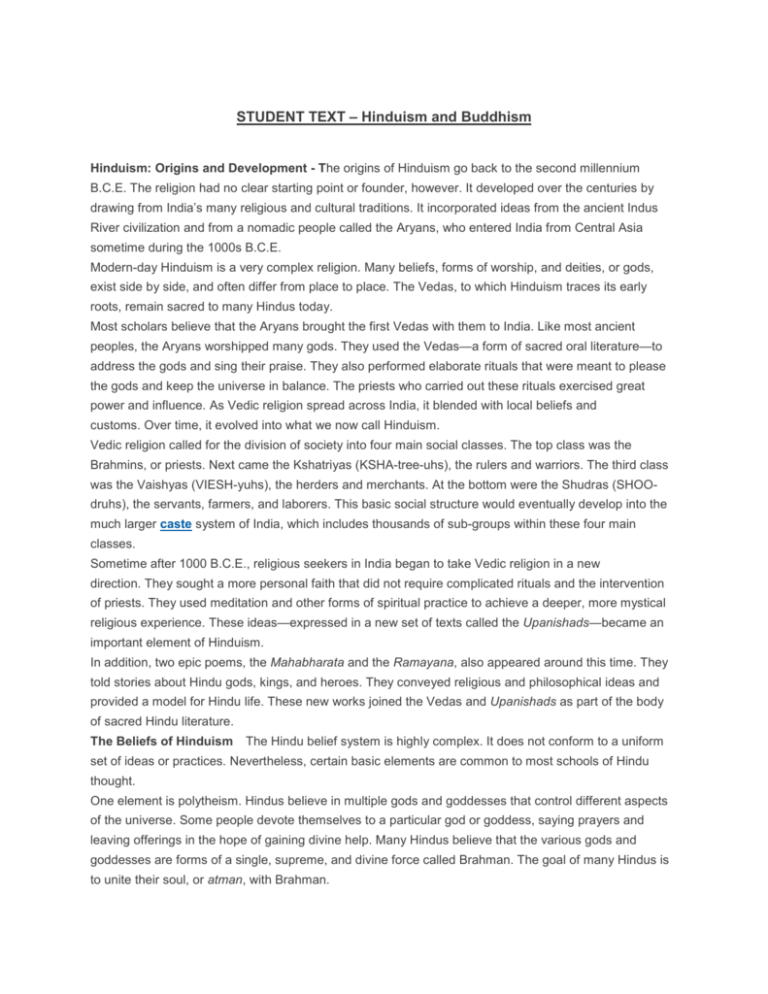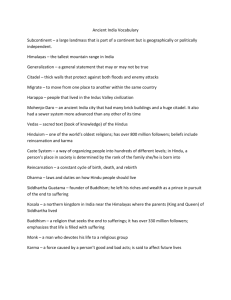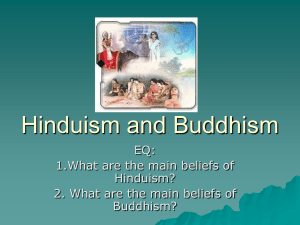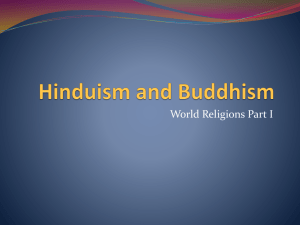STUDENT TEXT – Hinduism and Buddhism
advertisement

STUDENT TEXT – Hinduism and Buddhism Hinduism: Origins and Development - The origins of Hinduism go back to the second millennium B.C.E. The religion had no clear starting point or founder, however. It developed over the centuries by drawing from India’s many religious and cultural traditions. It incorporated ideas from the ancient Indus River civilization and from a nomadic people called the Aryans, who entered India from Central Asia sometime during the 1000s B.C.E. Modern-day Hinduism is a very complex religion. Many beliefs, forms of worship, and deities, or gods, exist side by side, and often differ from place to place. The Vedas, to which Hinduism traces its early roots, remain sacred to many Hindus today. Most scholars believe that the Aryans brought the first Vedas with them to India. Like most ancient peoples, the Aryans worshipped many gods. They used the Vedas—a form of sacred oral literature—to address the gods and sing their praise. They also performed elaborate rituals that were meant to please the gods and keep the universe in balance. The priests who carried out these rituals exercised great power and influence. As Vedic religion spread across India, it blended with local beliefs and customs. Over time, it evolved into what we now call Hinduism. Vedic religion called for the division of society into four main social classes. The top class was the Brahmins, or priests. Next came the Kshatriyas (KSHA-tree-uhs), the rulers and warriors. The third class was the Vaishyas (VIESH-yuhs), the herders and merchants. At the bottom were the Shudras (SHOOdruhs), the servants, farmers, and laborers. This basic social structure would eventually develop into the much larger caste system of India, which includes thousands of sub-groups within these four main classes. Sometime after 1000 B.C.E., religious seekers in India began to take Vedic religion in a new direction. They sought a more personal faith that did not require complicated rituals and the intervention of priests. They used meditation and other forms of spiritual practice to achieve a deeper, more mystical religious experience. These ideas—expressed in a new set of texts called the Upanishads—became an important element of Hinduism. In addition, two epic poems, the Mahabharata and the Ramayana, also appeared around this time. They told stories about Hindu gods, kings, and heroes. They conveyed religious and philosophical ideas and provided a model for Hindu life. These new works joined the Vedas and Upanishads as part of the body of sacred Hindu literature. The Beliefs of Hinduism The Hindu belief system is highly complex. It does not conform to a uniform set of ideas or practices. Nevertheless, certain basic elements are common to most schools of Hindu thought. One element is polytheism. Hindus believe in multiple gods and goddesses that control different aspects of the universe. Some people devote themselves to a particular god or goddess, saying prayers and leaving offerings in the hope of gaining divine help. Many Hindus believe that the various gods and goddesses are forms of a single, supreme, and divine force called Brahman. The goal of many Hindus is to unite their soul, or atman, with Brahman. Hindus believe that time moves in a great circle, like a giant wheel. Events repeat themselves, just as the seasons do. Birth, life, and death are part of this cycle. When people die, their soul is said to be reborn in a different body. This cycle of rebirth, called reincarnation, is a key feature of Hindu belief. Two other basic elements are dharma and karma. Dharma stands for law, duty, and obligation. Every Hindu has a dharma that reflects his or her caste in Indian society. People follow their dharma by performing their duties and living in an honorable way. Living honorably includes observing common social values, such as nonviolence and charity toward others. Karma refers to a person’s actions and the consequence of their actions. The law of karma says that people who live properly will have good karma and be reborn to a higher caste. Those who fail to live a proper life will have bad karma and be reborn to a lower caste, perhaps even as animals. The ultimate goal of Hindu belief is to escape reincarnation entirely. Devout Hindus believe that by living a spiritual life, they can free themselves from karma and attain moksha, or release, thus merging their soul with Brahman and ending the cycle of rebirth. The Spread and Influence of Hinduism Unlike Christianity and Islam, Hinduism did not spread far beyond its land of origin. Although its values are universal in many ways, Hinduism is strongly linked to Indian culture. Nevertheless, through trade and migration, Hindu beliefs and customs did spread to many parts of Southeast Asia. There they blended with local traditions and ways of life. Today, there are around 900 million followers of Hinduism, most of them in South Asia. Hindu beliefs are deeply woven into Indian society. So are Hindu festivals and the devotion to Hindu gods. Many Indians make religious pilgrimages to holy sites, such as Varanasi, where they purify themselves in the waters of the Ganges River. At the same time, certain Hindu ideas and practices, such as yoga, have also gained a following around the world. Buddhism: Origins and Development Buddhism embraced the ideas of karma and reincarnation.But it did not emphasize complex rituals, the caste system, or polytheism. Instead, it focused on the search for enlightenment, or pure wisdom. Buddhism arose from the teachings of Siddhartha Gautama (si-DAHR-tuh GOW-tuh-muh), who became the Buddha, or “enlightened one.” Siddhartha lived from about 563 to 483 B.C.E. According to tradition, he was born into a ruling family in northern India. As a youth, he enjoyed the privileged life of a prince. When he was 29 years old, however, he stepped outside his palace and saw the pain and suffering of the world. He was shocked by the reality of poverty, disease, and death. Soon after, he left his comfortable life to wander across India in search of a greater truth. Like many Indian mystics at the time, Siddhartha sought to achieve a higher consciousness through meditation and ascetic practices. (To be ascetic means to give up worldly pleasures.) According to Buddhist tradition, Siddhartha fasted to the point of starvation. After several years, however, he had still not attained the release he was seeking. He concluded that the path to truth could not be found in either the life of a prince or an ascetic. He decided to seek a “middle way” to enlightenment between the extremes of pleasure and pain. Buddhist tradition says that Siddhartha sat down under a large fig tree—known as a bodhi tree—and began to meditate. This went on for many days. Then one night, he reached a new level of consciousness. He envisioned his past lives and the effects of karma. He shed his desires and became enlightened. By morning, he had attained nirvana—a state of happiness and peace—and had become the Buddha. Although he had attained his goal and could now rest, Siddhartha felt a duty to help others. He began to teach his ideas and soon gained a following. Gradually, Buddhism began to spread across northern India. The Beliefs of Buddhism The basic teachings of Buddhism are known as the Four Noble Truths.These principles form the core of Buddhist thought. The first Noble Truth says, “Suffering is present in all things, and nothing lasts forever.” Disease, loss, and death are inevitable. Ignoring or denying this truth only leads to more suffering. A Buddhist should recognize this reality and offer kindness and compassion to those who suffer. The second truth says, “The cause of suffering is desire.” This means that the desire for pleasure, power, or possessions gives rise to suffering. Emotional attachment is another form of desire. The third truth says, “Removing desire removes suffering.” Buddhism teaches that the only way to end suffering is to eliminate desire. The fourth truth says, “The way to remove desire is to follow the Eightfold Path.” The Eightfold Path is a set of guidelines to achieve enlightenment. These are the eight guidelines: 1. Right understanding: Deeply understand the Four Noble Truths. 2. Right purpose: Live a life of selflessness, love, and nonviolence. 3. Right speech: Be careful and truthful in what you say. 4. Right action: Do not kill, steal, lie, or hurt others. 5. Right livelihood: Earn a living in ways that do no harm. 6. Right effort: Promote good actions and prevent evil actions. 7. Right mindfulness: Be aware of but not attached to your emotions, thoughts, or feelings. 8. Right concentration: Focus your mind with practices such as meditation. At the heart of Buddhist teachings is the idea that all things change. Even when one finds pleasure in life, it does not last forever, and one suffers when it is gone. The Eightfold Path offers a way to end suffering and find peace. This path follows the “middle way.” The Spread and Influence of Buddhism At first, Buddhist ideas spread slowly among religious seekers in India. In the 200s B.C.E., however, the Emperor Ashoka helped popularize Buddhism. Buddhist missionaries and traders carried the faith across South Asia and beyond. Although Hinduism remained dominant in India, Buddhism became the leading faith of Southeast Asia, Central Asia, and China. From China, it spread to Korea and Japan. As it expanded, Buddhism took on new forms by adapting to local customs and traditions. It divided into two major branches, Theravada and Mahayana. Theravada thrived in southern Asia and represented a more traditional style of Buddhism. Mahayana, which developed in northern Asia, embraced newer ideas. One form of Chinese Buddhism evolved in Japan to become Zen Buddhism, a form that emphasized meditation. Buddhism had a great impact wherever it went. Buddhists opened monasteries to promote the study and spread of Buddhist thought, which in turn influenced society and government. Many monasteries became wealthy and powerful through large donations of money and land. Faced with this growing power, Chinese rulers cracked down on the Buddhist faith in 845 C.E. But Buddhism continued to grow in other parts of Asia. Today, Buddhism is the fourth largest religion in the world, with 350 million followers. Buddhist teachings on nonviolence and respect for the natural world have influenced social and political movements worldwide.










